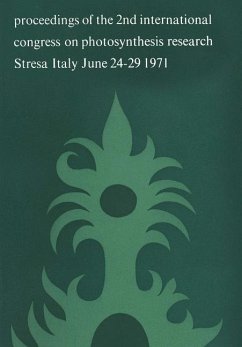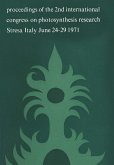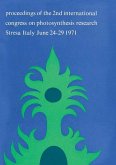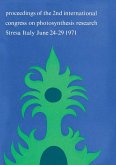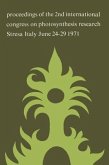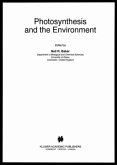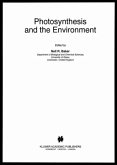Photosynthesis, two centuries after its discovery by Joseph Priestley
Proceedings of the IInd International Congress on Photosynthesis Research Stresa, June 24 ¿ 29, 1971 Volume 2 Ion transport and phosphorylation
Herausgegeben:Forti, G.; Avron, M.; Melandri, A.
Photosynthesis, two centuries after its discovery by Joseph Priestley
Proceedings of the IInd International Congress on Photosynthesis Research Stresa, June 24 ¿ 29, 1971 Volume 2 Ion transport and phosphorylation
Herausgegeben:Forti, G.; Avron, M.; Melandri, A.
- Broschiertes Buch
- Merkliste
- Auf die Merkliste
- Bewerten Bewerten
- Teilen
- Produkt teilen
- Produkterinnerung
- Produkterinnerung
The Second International Congress on Photosynthesis Research took place in Stresa, Italy during June 24-29, 1971; two centuries after the discovery of Photosynthesis by Joseph Priestley in 1771. This important anniversary was celebrated at the Congress by a learned account of Priestley's life and fundamental discoveries given by Professor Robin HILL, F. R. S. Professor HILL's lecture opens the first of the three volumes which contains the contributions presented at the Congress. The manuscripts have been distributed into three volumes. Volume I con tains contributions in the areas of primary…mehr
Andere Kunden interessierten sich auch für
![Photosynthesis, Two Centuries After Its Discovery by Joseph Priestley Photosynthesis, Two Centuries After Its Discovery by Joseph Priestley]() G. Forti / M. Avron / A. Melandri (eds.)Photosynthesis, Two Centuries After Its Discovery by Joseph Priestley159,99 €
G. Forti / M. Avron / A. Melandri (eds.)Photosynthesis, Two Centuries After Its Discovery by Joseph Priestley159,99 €![Photosynthesis, two centuries after its discovery by Joseph Priestley Photosynthesis, two centuries after its discovery by Joseph Priestley]() Photosynthesis, two centuries after its discovery by Joseph Priestley83,99 €
Photosynthesis, two centuries after its discovery by Joseph Priestley83,99 €![Photosynthesis, Two Centuries After Its Discovery by Joseph Priestley Photosynthesis, Two Centuries After Its Discovery by Joseph Priestley]() G. Forti / M. Avron / A. Melandri (eds.)Photosynthesis, Two Centuries After Its Discovery by Joseph Priestley159,99 €
G. Forti / M. Avron / A. Melandri (eds.)Photosynthesis, Two Centuries After Its Discovery by Joseph Priestley159,99 €![Photosynthesis, Two Centuries After Its Discovery by Joseph Priestley Photosynthesis, Two Centuries After Its Discovery by Joseph Priestley]() FortiPhotosynthesis, Two Centuries After Its Discovery by Joseph Priestley376,99 €
FortiPhotosynthesis, Two Centuries After Its Discovery by Joseph Priestley376,99 €![Environmental and Biological Control of Photosynthesis Environmental and Biological Control of Photosynthesis]() Environmental and Biological Control of Photosynthesis42,99 €
Environmental and Biological Control of Photosynthesis42,99 €![Photosynthesis and the Environment Photosynthesis and the Environment]() BakerPhotosynthesis and the Environment251,99 €
BakerPhotosynthesis and the Environment251,99 €![Photosynthesis and the Environment Photosynthesis and the Environment]() Photosynthesis and the Environment249,99 €
Photosynthesis and the Environment249,99 €-
-
-
The Second International Congress on Photosynthesis Research took place in Stresa, Italy during June 24-29, 1971; two centuries after the discovery of Photosynthesis by Joseph Priestley in 1771. This important anniversary was celebrated at the Congress by a learned account of Priestley's life and fundamental discoveries given by Professor Robin HILL, F. R. S. Professor HILL's lecture opens the first of the three volumes which contains the contributions presented at the Congress. The manuscripts have been distributed into three volumes. Volume I con tains contributions in the areas of primary reactions and electron transport; Volume II ion transport and photophosphorylation, and Volume III carbon assimilation, regulatory phenomena, developmental aspects, and from the two special sessions of the Congress devoted to evolution and photorespiration. It is realized that this division is necessarily somewhat arbitrary since many contributions relate to more than one of the above mentioned titles. However, the large number of contributions (over 3000 typed pages) made it impossible to publish the proceedings in less than three volumes. The printing of these volumes and the organization of the Congress were made possible by a contribution from the Consigio Nazionale delle Ricerche of Italy. The generous support of the Istituto Lombardo Acca demia di Scienze e Lettere to the publication of these proceedings is gratefully acknowledged. The editors wish to express their appreciation to all the scientists who contributed the results of the investigations, for their coopera tion; and to Drs.
Hinweis: Dieser Artikel kann nur an eine deutsche Lieferadresse ausgeliefert werden.
Hinweis: Dieser Artikel kann nur an eine deutsche Lieferadresse ausgeliefert werden.
Produktdetails
- Produktdetails
- Verlag: Springer / Springer Netherlands
- Artikelnr. des Verlages: 978-94-010-2940-7
- Softcover reprint of the original 1st ed. 1972
- Seitenzahl: 864
- Erscheinungstermin: 6. Februar 2012
- Englisch
- Abmessung: 244mm x 170mm x 46mm
- Gewicht: 1459g
- ISBN-13: 9789401029407
- ISBN-10: 9401029407
- Artikelnr.: 39503473
- Herstellerkennzeichnung Die Herstellerinformationen sind derzeit nicht verfügbar.
- Verlag: Springer / Springer Netherlands
- Artikelnr. des Verlages: 978-94-010-2940-7
- Softcover reprint of the original 1st ed. 1972
- Seitenzahl: 864
- Erscheinungstermin: 6. Februar 2012
- Englisch
- Abmessung: 244mm x 170mm x 46mm
- Gewicht: 1459g
- ISBN-13: 9789401029407
- ISBN-10: 9401029407
- Artikelnr.: 39503473
- Herstellerkennzeichnung Die Herstellerinformationen sind derzeit nicht verfügbar.
1. The Relation of Light Induced Reactions of Isolated Chloroplasts to Proton Concentration.- 1. The Relation of Light Induced Reactions of Isolated Chloroplasts to Proton Concentration.- 2. The High Energy State in Chloroplasts and Chromatophores.- 2. The High Energy State in Chloroplasts and Chromatophores.- 3. Correlation between Electrical Events in the Functioning Membranes of Photosynthesis and ATP Generation.- 3. Correlation between Electrical Events in the Functioning Membranes of Photosynthesis and ATP Generation.- 4. The Effect of ADP, ATP and Dio-9 on the H002B002F0065-ratio in Spinach Chloroplasts.- 4. The Effect of ADP, ATP and Dio-9 on the H002B002F0065-ratio in Spinach Chloroplasts.- 5. Relationship between Ion Transport Phenomena and Phosphorylation in Chloroplasts.- 5. Relationship between Ion Transport Phenomena and Phosphorylation in Chloroplasts.- 6. On the Metastable States of Carotenoids in Primary Events of Photosynthesis.- 6. On the Metastable States of Carotenoids in Primary Events of Photosynthesis.- 7. Energization of the Chloroplast Membrane as Revealed by Fluorescent Probes.- 7. Energization of the Chloroplast Membrane as Revealed by Fluorescent Probes.- 8. Investigations on pH-dependent and Energy linked Delayed Light Emission in Chloroplasts.- 8. Investigations on pH-dependent and Energy linked Delayed Light Emission in Chloroplasts.- 9. Ion Gradient Effects in the Stimulation of Delayed Light from Chloroplasts.- 9. Ion Gradient Effects in the Stimulation of Delayed Light from Chloroplasts.- 10. The Effect of Antimycin A and 1:10 Phenantroline on Rapid H002B uptake by Chromatophores from Rhodopseudomonas spheroides.- 10. The Effect of Antimycin A and 1:10 Phenantroline on Rapid H002B uptake by Chromatophores from Rhodopseudomonas spheroides.- 11. Two Fluorescent Probes Reflecting Different Light-Induced Processes in Rhodo spirillum rubrum chromatophores.- 11. Two Fluorescent Probes Reflecting Different Light-Induced Processes in Rhodo spirillum rubrum chromatophores.- 12. In situ Thermodynamic and Kinetic Characterization of Components of Photosynthetic Electron Transport in Rhodopseudomonas spheroides.- 12. In situ Thermodynamic and Kinetic Characterization of Components of Photosynthetic Electron Transport in Rhodopseudomonas spheroides.- 13. The Redox Potential Dependency of Coupled Electron Flow in Chromatophores from Rhodopseudomonas spheroides.- 13. The Redox Potential Dependency of Coupled Electron Flow in Chromatophores from Rhodopseudomonas spheroides.- 14. 3-Bromo-B-nitrostyrene: a New Energy Transfer Inhibitor in Chloroplast Photophosphorylation.- 14. 3-Bromo-B-nitrostyrene: a New Energy Transfer Inhibitor in Chloroplast Photophosphorylation.- 15. Hydrogen and Proton Transfer across the Chloroplast Envelope.- 15. Hydrogen and Proton Transfer across the Chloroplast Envelope.- 16. The Determination of ApH in Chloroplasts and Subchloroplast Particles.- 16. The Determination of ApH in Chloroplasts and Subchloroplast Particles.- 17. Photosynthetic Electron Flow and Associated Changes in Electrical Potential and Resistance of Cytoplasmic Membranes in Green Plant Cells.- 17. Photosynthetic Electron Flow and Associated Changes in Electrical Potential and Resistance of Cytoplasmic Membranes in Green Plant Cells.- 18. Proton Flux and ATP Formation in Chloroplasts.- 18. Proton Flux and ATP Formation in Chloroplasts.- 19. On the Molecular Mechanisms of Passive and Active Ion Translocation across the Thylakoid Membrane.- 19. On the Molecular Mechanisms of Passive and Active Ion Translocation across the Thylakoid Membrane.- 20. Functions of Enolphosphates and Epoxycarotenoids in Photophosphorylation.- 20. Functions of Enolphosphates and Epoxycarotenoids in Photophosphorylation.- 21. The Effect of Dinactin on Potassium Transport in Chloroplasts.- 21. The Effect of Dinactin on Potassium Transport in Chloroplasts.- 22. Electrochromic Measurements "in vitro" as a test for the Interpretation of Field Indicating Absorption Changes in Photosynthesis.- 22. Electrochromic Measurements "in vitro" as a test for the Interpretation of Field Indicating Absorption Changes in Photosynthesis.- 23. Resolution and Reconstitut ion of the System of Photophosphorylation.- 23. Resolution and Reconstitut ion of the System of Photophosphorylation.- 24. Hypothesis for a Mechanism of Energy Transduction Sigmoidal Kinetics of Chloroplast's Heat Activated ATPase.- 24. Hypothesis for a Mechanism of Energy Transduction Sigmoidal Kinetics of Chloroplast's Heat Activated ATPase.- 25. The Relationship of DCCD-Membrane Interaction to Coupling Factor Function in the Proton Pump.- 25. The Relationship of DCCD-Membrane Interaction to Coupling Factor Function in the Proton Pump.- 26. Factors Affecting the Light Induction of ATP Hydrolysis in the Dark by "Class II" Chloroplasts.- 26. Factors Affecting the Light Induction of ATP Hydrolysis in the Dark by "Class II" Chloroplasts.- 27. Some Properties of Coupling Factor (CF) Extracted from Spinach Chloroplasts.- 27. Some Properties of Coupling Factor (CF) Extracted from Spinach Chloroplasts.- 28. Membrane-Bound Phosphate in Chromatophores of Rhodospirilium rubrum. I. Isolation by Zonal Centrifugation.- 28. Membrane-Bound Phosphate in Chromatophores of Rhodospirilium rubrum. I. Isolation by Zonal Centrifugation.- 29. Membrane-Bound Phosphate inChromatophores of Rhodospirillumrubrum. II. Its Relation to Photophosphorylation.- 29. Membrane-Bound Phosphate in Chromatophores of Rhodospirillumrubrum. II. Its Relation to Photophosphorylation.- 30. Energy Transduction in Photosynthetic Bacteria. I. Properties of Solubilized and Reconstituted ATPase in Rhodopseudomonas capsulata Photosynthetic Membranes.- 30. Energy Transduction in Photosynthetic Bacteria. I. Properties of Solubilized and Reconstituted ATPase in Rhodopseudomonas capsulata Photosynthetic Membranes.- 31. Energy Transduction in Photosynthetic Bacteria. II. Coupling Factors from Aerobically and Photosynthetically Grown Cells of Rhodopseudomonas capsulata.- 31. Energy Transduction in Photosynthetic Bacteria. II. Coupling Factors from Aerobically and Photosynthetically Grown Cells of Rhodopseudomonas capsulata.- 32. A Chlamydomonas reinhardi Mutant with no Photosynthetic ATP Forming Capacity.- 32. A Chlamydomonas reinhardi Mutant with no Photosynthetic ATP Forming Capacity.- 33. Coupling Factor Capabilities from Chromatophores fragments of Rhodospirillum rubrum.- 33. Coupling Factor Capabilities from Chromatophores fragments of Rhodospirillum rubrum.- 34. Non-cyclic Electron Transport and Photophosphorylation in Rhodospirillum rubrum Chromatophores.- 34. Non-cyclic Electron Transport and Photophosphorylation in Rhodospirillum rubrum Chromatophores.- 35. On the Interaction of ATP with the Energy Conservation System in Chloroplasts.- 35. On the Interaction of ATP with the Energy Conservation System in Chloroplasts.- 36. Energy-Linked Reactions in Photosynthetic Bacteria: VIII. Role of Energy-Linked Reactions in the Cell.- 36. Energy-Linked Reactions in Photosynthetic Bacteria: VIII. Role of Energy-Linked Reactions in the Cell.- 37. Catalytic Properties andRegulatory Behaviour of Cytoplasmic Pyrophosphatases of Nonsulfur Purple Photosynthetic Bacteria.- 37. Catalytic Properties and Regulatory Behaviour of Cytoplasmic Pyrophosphatases of Nonsulfur Purple Photosynthetic Bacteria.- 38. Properties of a Phospholipid-Dependent Inorganic Pyrophosphatase (PPase) in Rhodospirillum rubrum membranes.- 38. Properties of a Phospholipid-Dependent Inorganic Pyrophosphatase (PPase) in Rhodospirillum rubrum membranes.- 39. Cyclic Photophosphorylation.- 39. Cyclic Photophosphorylation.- 40. Two sites for ATP Formation in Photosynthetic Electron Transport Mediated by Photosystem I. Evidence from Digitonin Subchloroplast Particles and Chloroplasts.- 40. Two sites for ATP Formation in Photosynthetic Electron Transport Mediated by Photosystem I. Evidence from Digitonin Subchloroplast Particles and Chloroplasts.- 41. Role of Cyclic Photophosphorylation in Photosynthetic Carbon Dioxide Assimilation by Isolated Chloroplasts.- 41. Role of Cyclic Photophosphorylation in Photosynthetic Carbon Dioxide Assimilation by Isolated Chloroplasts.- 42. Effects of 2-Methoxy-4,6-bis(Ethylamino)-1,3,5-Triazine on Oxygen Evolution and Cyclic Photophosphorylation in Soenedesmus.- 42. Effects of 2-Methoxy-4,6-bis(Ethylamino)-1,3,5-Triazine on Oxygen Evolution and Cyclic Photophosphorylation in Soenedesmus.- 43. Effect of Magnesium Ions on Two Stages Phosphorylation and on the Formation of an Hypothetical High Energy Phosphorylated Compound (X~P) Percursor of ATP.- 43. Effect of Magnesium Ions on Two Stages Phosphorylation and on the Formation of an Hypothetical High Energy Phosphorylated Compound (X~P) Percursor of ATP.- 44. Effect of Dio-9 on the Electron Transport in Chloroplasts Depleted of Endogenous P.- 44. Effect of Dio-9 on the Electron Transport in Chloroplasts Depleted of Endogenous Pi.- 45. Activation of Photosynthetic Electron Transport by Phosphate Related to Phosphate Translocation across the Thylakoid Membrane.- 45. Activation of Photosynthetic Electron Transport by Phosphate Related to Phosphate Translocation across the Thylakoid Membrane.- 46. Comparative Estimation of Cyclic and Noncyclic Photophosphorylation in N2 by Ankistrodesmus braunii "in vivo".- 46. Comparative Estimation of Cyclic and Noncyclic Photophosphorylation in N2 by Ankistrodesmus braunii "in vivo".- 47. The Phosphate Translocator of Spinach Chloroplasts.- 47. The Phosphate Translocator of Spinach Chloroplasts.- 48. Differentation of the Permeability Properties of the Two Membranes of Chloroplast Envelope.- 48. Differentation of the Permeability Properties of the Two Membranes of Chloroplast Envelope.- 49. Correlation of Stoichiometry of Photophosphorylation with the Integrity of Isolated Spinach Chloroplasts.- 49. Correlation of Stoichiometry of Photophosphorylation with the Integrity of Isolated Spinach Chloroplasts.- 50. The Level of ATP in Chlorella.- 50. The Level of ATP in Chlorella.- 51. Influence of Light Conditions, Gassing and Inhibitors on Photophosphorylation and ATP Level in Anacystis nidulans.- 51. Influence of Light Conditions, Gassing and Inhibitors on Photophosphorylation and ATP Level in Anacystis nidulans.- 52. Effect of Neutron Irradiation on Adenine Nucleotides of Spinach Chloroplasts.- 52. Effect of Neutron Irradiation on Adenine Nucleotides of Spinach Chloroplasts.- 53. Increased Oxygen Evolution and Peaks of Adenine Triphosphate on Synchronized Soenedesmus, caused by 3, 4-dichlorophenyl-dimethylurea.- 53. Increased Oxygen Evolution and Peaks of Adenine Triphosphate on Synchronized Soenedesmus, caused by 3,4-dichlorophenyl-dimethylurea.- 54. Changes of ATP Levels in Green Algae and Intact Chloroplasts by Different Photosynthetic Reactions.- 54. Changes of ATP Levels in Green Algae and Intact Chloroplasts by Different Photosynthetic Reactions.- 55. Uncoupling of Photophosphorylation by Quaternary Ammonium Salts and Zwitterionic Buffers.- 55. Uncoupling of Photophosphorylation by Quaternary Ammonium Salts and Zwitterionic Buffers.- 56. Freeze-etch Studies on Chloroplast Thylakoids.- 57. The Isolation and Characterization of Plastid Envelope Membranes.- 58. The Structure of Chromatophore Membranes from Strain R-26 of Rhodopseudomonas sphevoides.- 59. On the Chemical Nature of Reaction Center Bacteriochlorophyll.- 60. Photosentized Degradation Reaction and their Possible Influence on the Photochemical Activities in Isolated Chloroplasts.- 61. Ultrastructure and Molecular Composition of Membranes in Dimorphic Chloroplasts of Zea mays.- 62. Accumulation of Pigments and Fragmentation Characteristics of Mesophyll and Bundle-sheath Chloroplasts of Maize.- 63. Isolation of Plastids from Different Regions of Developing Maize Leaves.- 64. Digitonin Fragmentation of Spinach and Maize Chloroplasts Distribution of Chlorophylls between Particle Fractions.- 65. Chlorophyll-protein-detergent Complexes Compared with Thylakoids by Means of Circular Dichroism.- 66. Chlorophyll b in Preparations of Photosystem I and II.- 67. Ionic Induced Changes in the Membrane Structure and Fluorescence of Intact and Glutaraldehyde Fixed Porphyridium cruentum Chloroplasts in vivo.- 68. Luminescence in Leaves.- 69. Chlorophyll Fluorescence: a Spectroscopic Probe of the Fine Structure of the Photosynthetic Membranes.- Fluorescence and Absorption of Small Green Particles Isolated from Leaves of Different Plants.- Light-induced Changes in Chloroplasts Volume, their Ultrastructure and Photophosphorylation in Connection with Water Supply and Age of Plants.- 72. Aggregated States of Membrane Proteins of Photosynthetic Organelles.- 73. Physico-chemical Study of Plastidial Structure Proteins from Zea-mays L.- 74. Study of a Non Chlorophyllic Mg Fraction Linked to Membrane Proteins of Plastids from Zea mays L.- 75. Some Observations on Cytochrome f.- 76. The Effect of an Anti-Chiorophy11 Serum on Photosynthetic Electron Transport.- 77. Antiserum to Chlorophyll and its Reactions with Chloroplasts.- 78. On the Role of Lipid Components in Molecular Organisation of Photosynthetic System of High Plants.- 79. On the Lipid Composition of Chloroplast System I Particles.- 80. Heterogeneity and Structural Role of Lipids in Chloroplast Membranes.- 81. Lipid Components of Chloroplasts Isolated from Spirodela polyrrhiza Light-culviated on.- 82. Lability of Photosystem II in Chloroplasts of Carotenoid Deficient Maize Leaves.- 83. On the State and Extrastability of Carotenoid Pigments in Dark.- 84. Effect of Potassium Deficiency on the Pigment Content of the Leaves and the Intensity of Photosynthesis of Beans.- 85. Photoreactive Pigments in Flower Petals.- 86. Occurrence of C-Glycosylflavone in the Leaves and the Chloroplasts of Melon (Cucumis melo).- Authors' Index.'1. The Relation of Light Induced Reactions of Isolated Chloroplasts to Proton Concentration.- 1. The Relation of Light Induced Reactions of Isolated Chloroplasts to Proton Concentration.- 2. The High Energy State in Chloroplasts and Chromatophores.- 2. The High Energy State in Chloroplasts and Chromatophores.- 3. Correlation between Electrical Events in the Functioning Membranes of Photosynthesis and ATP Generation.- 3. Correlation between Electrical Events in the Functioning Membranes of Photosynthesis and ATP Generation.- 4. The Effect of ADP, ATP and Dio-9 on the H002B002F0065-ratio in Spinach Chloroplasts.- 4. The Effect of ADP, ATP and Dio-9 on the H002B002F0065-ratio in Spinach Chloroplasts.- 5. Relationship between Ion Transport Phenomena and Phosphorylation in Chloroplasts.- 5. Relationship between Ion Transport Phenomena and Phosphorylation in Chloroplasts.- 6. On the Metastable States of Carotenoids in Primary Events of Photosynthesis.- 6. On the Metastable States of Carotenoids in Primary Events of Photosynthesis.- 7. Energization of the Chloroplast Membrane as Revealed by Fluorescent Probes.- 7. Energization of the Chloroplast Membrane as Revealed by Fluorescent Probes.- 8. Investigations on pH-dependent and Energy linked Delayed Light Emission in Chloroplasts.- 8. Investigations on pH-dependent and Energy linked Delayed Light Emission in Chloroplasts.- 9. Ion Gradient Effects in the Stimulation of Delayed Light from Chloroplasts.- 9. Ion Gradient Effects in the Stimulation of Delayed Light from Chloroplasts.- 10. The Effect of Antimycin A and 1:10 Phenantroline on Rapid H002B uptake by Chromatophores from Rhodopseudomonas spheroides.- 10. The Effect of Antimycin A and 1:10 Phenantroline on Rapid H002B uptake by Chromatophores from Rhodopseudomonas spheroides.- 11. Two Fluorescent Probes Reflecting Different Light-Induced Processes in Rhodo spirillum rubrum chromatophores.- 11. Two Fluorescent Probes Reflecting Different Light-Induced Processes in Rhodo spirillum rubrum chromatophores.- 12. In situ Thermodynamic and Kinetic Characterization of Components of Photosynthetic Electron Transport in Rhodopseudomonas spheroides.- 12. In situ Thermodynamic and Kinetic Characterization of Components of Photosynthetic Electron Transport in Rhodopseudomonas spheroides.- 13. The Redox Potential Dependency of Coupled Electron Flow in Chromatophores from Rhodopseudomonas spheroides.- 13. The Redox Potential Dependency of Coupled Electron Flow in Chromatophores from Rhodopseudomonas spheroides.- 14. 3-Bromo-B-nitrostyrene: a New Energy Transfer Inhibitor in Chloroplast Photophosphorylation.- 14. 3-Bromo-B-nitrostyrene: a New Energy Transfer Inhibitor in Chloroplast Photophosphorylation.- 15. Hydrogen and Proton Transfer across the Chloroplast Envelope.- 15. Hydrogen and Proton Transfer across the Chloroplast Envelope.- 16. The Determination of ApH in Chloroplasts and Subchloroplast Particles.- 16. The Determination of ApH in Chloroplasts and Subchloroplast Particles.- 17. Photosynthetic Electron Flow and Associated Changes in Electrical Potential and Resistance of Cytoplasmic Membranes in Green Plant Cells.- 17. Photosynthetic Electron Flow and Associated Changes in Electrical Potential and Resistance of Cytoplasmic Membranes in Green Plant Cells.- 18. Proton Flux and ATP Formation in Chloroplasts.- 18. Proton Flux and ATP Formation in Chloroplasts.- 19. On the Molecular Mechanisms of Passive and Active Ion Translocation across the Thylakoid Membrane.- 19. On the Molecular Mechanisms of Passive and Active Ion Translocation across the Thylakoid Membrane.- 20. Functions of Enolphosphates and Epoxycarotenoids in Photophosphorylation.- 20. Functions of Enolphosphates and Epoxycarotenoids in Photophosphorylation.- 21. The Effect of Dinactin on Potassium Transport in Chloroplasts.- 21. The Effect of Dinactin on Potassium Transport in Chl
1. The Relation of Light Induced Reactions of Isolated Chloroplasts to Proton Concentration.- 1. The Relation of Light Induced Reactions of Isolated Chloroplasts to Proton Concentration.- 2. The High Energy State in Chloroplasts and Chromatophores.- 2. The High Energy State in Chloroplasts and Chromatophores.- 3. Correlation between Electrical Events in the Functioning Membranes of Photosynthesis and ATP Generation.- 3. Correlation between Electrical Events in the Functioning Membranes of Photosynthesis and ATP Generation.- 4. The Effect of ADP, ATP and Dio-9 on the H002B002F0065-ratio in Spinach Chloroplasts.- 4. The Effect of ADP, ATP and Dio-9 on the H002B002F0065-ratio in Spinach Chloroplasts.- 5. Relationship between Ion Transport Phenomena and Phosphorylation in Chloroplasts.- 5. Relationship between Ion Transport Phenomena and Phosphorylation in Chloroplasts.- 6. On the Metastable States of Carotenoids in Primary Events of Photosynthesis.- 6. On the Metastable States of Carotenoids in Primary Events of Photosynthesis.- 7. Energization of the Chloroplast Membrane as Revealed by Fluorescent Probes.- 7. Energization of the Chloroplast Membrane as Revealed by Fluorescent Probes.- 8. Investigations on pH-dependent and Energy linked Delayed Light Emission in Chloroplasts.- 8. Investigations on pH-dependent and Energy linked Delayed Light Emission in Chloroplasts.- 9. Ion Gradient Effects in the Stimulation of Delayed Light from Chloroplasts.- 9. Ion Gradient Effects in the Stimulation of Delayed Light from Chloroplasts.- 10. The Effect of Antimycin A and 1:10 Phenantroline on Rapid H002B uptake by Chromatophores from Rhodopseudomonas spheroides.- 10. The Effect of Antimycin A and 1:10 Phenantroline on Rapid H002B uptake by Chromatophores from Rhodopseudomonas spheroides.- 11. Two Fluorescent Probes Reflecting Different Light-Induced Processes in Rhodo spirillum rubrum chromatophores.- 11. Two Fluorescent Probes Reflecting Different Light-Induced Processes in Rhodo spirillum rubrum chromatophores.- 12. In situ Thermodynamic and Kinetic Characterization of Components of Photosynthetic Electron Transport in Rhodopseudomonas spheroides.- 12. In situ Thermodynamic and Kinetic Characterization of Components of Photosynthetic Electron Transport in Rhodopseudomonas spheroides.- 13. The Redox Potential Dependency of Coupled Electron Flow in Chromatophores from Rhodopseudomonas spheroides.- 13. The Redox Potential Dependency of Coupled Electron Flow in Chromatophores from Rhodopseudomonas spheroides.- 14. 3-Bromo-B-nitrostyrene: a New Energy Transfer Inhibitor in Chloroplast Photophosphorylation.- 14. 3-Bromo-B-nitrostyrene: a New Energy Transfer Inhibitor in Chloroplast Photophosphorylation.- 15. Hydrogen and Proton Transfer across the Chloroplast Envelope.- 15. Hydrogen and Proton Transfer across the Chloroplast Envelope.- 16. The Determination of ApH in Chloroplasts and Subchloroplast Particles.- 16. The Determination of ApH in Chloroplasts and Subchloroplast Particles.- 17. Photosynthetic Electron Flow and Associated Changes in Electrical Potential and Resistance of Cytoplasmic Membranes in Green Plant Cells.- 17. Photosynthetic Electron Flow and Associated Changes in Electrical Potential and Resistance of Cytoplasmic Membranes in Green Plant Cells.- 18. Proton Flux and ATP Formation in Chloroplasts.- 18. Proton Flux and ATP Formation in Chloroplasts.- 19. On the Molecular Mechanisms of Passive and Active Ion Translocation across the Thylakoid Membrane.- 19. On the Molecular Mechanisms of Passive and Active Ion Translocation across the Thylakoid Membrane.- 20. Functions of Enolphosphates and Epoxycarotenoids in Photophosphorylation.- 20. Functions of Enolphosphates and Epoxycarotenoids in Photophosphorylation.- 21. The Effect of Dinactin on Potassium Transport in Chloroplasts.- 21. The Effect of Dinactin on Potassium Transport in Chloroplasts.- 22. Electrochromic Measurements "in vitro" as a test for the Interpretation of Field Indicating Absorption Changes in Photosynthesis.- 22. Electrochromic Measurements "in vitro" as a test for the Interpretation of Field Indicating Absorption Changes in Photosynthesis.- 23. Resolution and Reconstitut ion of the System of Photophosphorylation.- 23. Resolution and Reconstitut ion of the System of Photophosphorylation.- 24. Hypothesis for a Mechanism of Energy Transduction Sigmoidal Kinetics of Chloroplast's Heat Activated ATPase.- 24. Hypothesis for a Mechanism of Energy Transduction Sigmoidal Kinetics of Chloroplast's Heat Activated ATPase.- 25. The Relationship of DCCD-Membrane Interaction to Coupling Factor Function in the Proton Pump.- 25. The Relationship of DCCD-Membrane Interaction to Coupling Factor Function in the Proton Pump.- 26. Factors Affecting the Light Induction of ATP Hydrolysis in the Dark by "Class II" Chloroplasts.- 26. Factors Affecting the Light Induction of ATP Hydrolysis in the Dark by "Class II" Chloroplasts.- 27. Some Properties of Coupling Factor (CF) Extracted from Spinach Chloroplasts.- 27. Some Properties of Coupling Factor (CF) Extracted from Spinach Chloroplasts.- 28. Membrane-Bound Phosphate in Chromatophores of Rhodospirilium rubrum. I. Isolation by Zonal Centrifugation.- 28. Membrane-Bound Phosphate in Chromatophores of Rhodospirilium rubrum. I. Isolation by Zonal Centrifugation.- 29. Membrane-Bound Phosphate inChromatophores of Rhodospirillumrubrum. II. Its Relation to Photophosphorylation.- 29. Membrane-Bound Phosphate in Chromatophores of Rhodospirillumrubrum. II. Its Relation to Photophosphorylation.- 30. Energy Transduction in Photosynthetic Bacteria. I. Properties of Solubilized and Reconstituted ATPase in Rhodopseudomonas capsulata Photosynthetic Membranes.- 30. Energy Transduction in Photosynthetic Bacteria. I. Properties of Solubilized and Reconstituted ATPase in Rhodopseudomonas capsulata Photosynthetic Membranes.- 31. Energy Transduction in Photosynthetic Bacteria. II. Coupling Factors from Aerobically and Photosynthetically Grown Cells of Rhodopseudomonas capsulata.- 31. Energy Transduction in Photosynthetic Bacteria. II. Coupling Factors from Aerobically and Photosynthetically Grown Cells of Rhodopseudomonas capsulata.- 32. A Chlamydomonas reinhardi Mutant with no Photosynthetic ATP Forming Capacity.- 32. A Chlamydomonas reinhardi Mutant with no Photosynthetic ATP Forming Capacity.- 33. Coupling Factor Capabilities from Chromatophores fragments of Rhodospirillum rubrum.- 33. Coupling Factor Capabilities from Chromatophores fragments of Rhodospirillum rubrum.- 34. Non-cyclic Electron Transport and Photophosphorylation in Rhodospirillum rubrum Chromatophores.- 34. Non-cyclic Electron Transport and Photophosphorylation in Rhodospirillum rubrum Chromatophores.- 35. On the Interaction of ATP with the Energy Conservation System in Chloroplasts.- 35. On the Interaction of ATP with the Energy Conservation System in Chloroplasts.- 36. Energy-Linked Reactions in Photosynthetic Bacteria: VIII. Role of Energy-Linked Reactions in the Cell.- 36. Energy-Linked Reactions in Photosynthetic Bacteria: VIII. Role of Energy-Linked Reactions in the Cell.- 37. Catalytic Properties andRegulatory Behaviour of Cytoplasmic Pyrophosphatases of Nonsulfur Purple Photosynthetic Bacteria.- 37. Catalytic Properties and Regulatory Behaviour of Cytoplasmic Pyrophosphatases of Nonsulfur Purple Photosynthetic Bacteria.- 38. Properties of a Phospholipid-Dependent Inorganic Pyrophosphatase (PPase) in Rhodospirillum rubrum membranes.- 38. Properties of a Phospholipid-Dependent Inorganic Pyrophosphatase (PPase) in Rhodospirillum rubrum membranes.- 39. Cyclic Photophosphorylation.- 39. Cyclic Photophosphorylation.- 40. Two sites for ATP Formation in Photosynthetic Electron Transport Mediated by Photosystem I. Evidence from Digitonin Subchloroplast Particles and Chloroplasts.- 40. Two sites for ATP Formation in Photosynthetic Electron Transport Mediated by Photosystem I. Evidence from Digitonin Subchloroplast Particles and Chloroplasts.- 41. Role of Cyclic Photophosphorylation in Photosynthetic Carbon Dioxide Assimilation by Isolated Chloroplasts.- 41. Role of Cyclic Photophosphorylation in Photosynthetic Carbon Dioxide Assimilation by Isolated Chloroplasts.- 42. Effects of 2-Methoxy-4,6-bis(Ethylamino)-1,3,5-Triazine on Oxygen Evolution and Cyclic Photophosphorylation in Soenedesmus.- 42. Effects of 2-Methoxy-4,6-bis(Ethylamino)-1,3,5-Triazine on Oxygen Evolution and Cyclic Photophosphorylation in Soenedesmus.- 43. Effect of Magnesium Ions on Two Stages Phosphorylation and on the Formation of an Hypothetical High Energy Phosphorylated Compound (X~P) Percursor of ATP.- 43. Effect of Magnesium Ions on Two Stages Phosphorylation and on the Formation of an Hypothetical High Energy Phosphorylated Compound (X~P) Percursor of ATP.- 44. Effect of Dio-9 on the Electron Transport in Chloroplasts Depleted of Endogenous P.- 44. Effect of Dio-9 on the Electron Transport in Chloroplasts Depleted of Endogenous Pi.- 45. Activation of Photosynthetic Electron Transport by Phosphate Related to Phosphate Translocation across the Thylakoid Membrane.- 45. Activation of Photosynthetic Electron Transport by Phosphate Related to Phosphate Translocation across the Thylakoid Membrane.- 46. Comparative Estimation of Cyclic and Noncyclic Photophosphorylation in N2 by Ankistrodesmus braunii "in vivo".- 46. Comparative Estimation of Cyclic and Noncyclic Photophosphorylation in N2 by Ankistrodesmus braunii "in vivo".- 47. The Phosphate Translocator of Spinach Chloroplasts.- 47. The Phosphate Translocator of Spinach Chloroplasts.- 48. Differentation of the Permeability Properties of the Two Membranes of Chloroplast Envelope.- 48. Differentation of the Permeability Properties of the Two Membranes of Chloroplast Envelope.- 49. Correlation of Stoichiometry of Photophosphorylation with the Integrity of Isolated Spinach Chloroplasts.- 49. Correlation of Stoichiometry of Photophosphorylation with the Integrity of Isolated Spinach Chloroplasts.- 50. The Level of ATP in Chlorella.- 50. The Level of ATP in Chlorella.- 51. Influence of Light Conditions, Gassing and Inhibitors on Photophosphorylation and ATP Level in Anacystis nidulans.- 51. Influence of Light Conditions, Gassing and Inhibitors on Photophosphorylation and ATP Level in Anacystis nidulans.- 52. Effect of Neutron Irradiation on Adenine Nucleotides of Spinach Chloroplasts.- 52. Effect of Neutron Irradiation on Adenine Nucleotides of Spinach Chloroplasts.- 53. Increased Oxygen Evolution and Peaks of Adenine Triphosphate on Synchronized Soenedesmus, caused by 3, 4-dichlorophenyl-dimethylurea.- 53. Increased Oxygen Evolution and Peaks of Adenine Triphosphate on Synchronized Soenedesmus, caused by 3,4-dichlorophenyl-dimethylurea.- 54. Changes of ATP Levels in Green Algae and Intact Chloroplasts by Different Photosynthetic Reactions.- 54. Changes of ATP Levels in Green Algae and Intact Chloroplasts by Different Photosynthetic Reactions.- 55. Uncoupling of Photophosphorylation by Quaternary Ammonium Salts and Zwitterionic Buffers.- 55. Uncoupling of Photophosphorylation by Quaternary Ammonium Salts and Zwitterionic Buffers.- 56. Freeze-etch Studies on Chloroplast Thylakoids.- 57. The Isolation and Characterization of Plastid Envelope Membranes.- 58. The Structure of Chromatophore Membranes from Strain R-26 of Rhodopseudomonas sphevoides.- 59. On the Chemical Nature of Reaction Center Bacteriochlorophyll.- 60. Photosentized Degradation Reaction and their Possible Influence on the Photochemical Activities in Isolated Chloroplasts.- 61. Ultrastructure and Molecular Composition of Membranes in Dimorphic Chloroplasts of Zea mays.- 62. Accumulation of Pigments and Fragmentation Characteristics of Mesophyll and Bundle-sheath Chloroplasts of Maize.- 63. Isolation of Plastids from Different Regions of Developing Maize Leaves.- 64. Digitonin Fragmentation of Spinach and Maize Chloroplasts Distribution of Chlorophylls between Particle Fractions.- 65. Chlorophyll-protein-detergent Complexes Compared with Thylakoids by Means of Circular Dichroism.- 66. Chlorophyll b in Preparations of Photosystem I and II.- 67. Ionic Induced Changes in the Membrane Structure and Fluorescence of Intact and Glutaraldehyde Fixed Porphyridium cruentum Chloroplasts in vivo.- 68. Luminescence in Leaves.- 69. Chlorophyll Fluorescence: a Spectroscopic Probe of the Fine Structure of the Photosynthetic Membranes.- Fluorescence and Absorption of Small Green Particles Isolated from Leaves of Different Plants.- Light-induced Changes in Chloroplasts Volume, their Ultrastructure and Photophosphorylation in Connection with Water Supply and Age of Plants.- 72. Aggregated States of Membrane Proteins of Photosynthetic Organelles.- 73. Physico-chemical Study of Plastidial Structure Proteins from Zea-mays L.- 74. Study of a Non Chlorophyllic Mg Fraction Linked to Membrane Proteins of Plastids from Zea mays L.- 75. Some Observations on Cytochrome f.- 76. The Effect of an Anti-Chiorophy11 Serum on Photosynthetic Electron Transport.- 77. Antiserum to Chlorophyll and its Reactions with Chloroplasts.- 78. On the Role of Lipid Components in Molecular Organisation of Photosynthetic System of High Plants.- 79. On the Lipid Composition of Chloroplast System I Particles.- 80. Heterogeneity and Structural Role of Lipids in Chloroplast Membranes.- 81. Lipid Components of Chloroplasts Isolated from Spirodela polyrrhiza Light-culviated on.- 82. Lability of Photosystem II in Chloroplasts of Carotenoid Deficient Maize Leaves.- 83. On the State and Extrastability of Carotenoid Pigments in Dark.- 84. Effect of Potassium Deficiency on the Pigment Content of the Leaves and the Intensity of Photosynthesis of Beans.- 85. Photoreactive Pigments in Flower Petals.- 86. Occurrence of C-Glycosylflavone in the Leaves and the Chloroplasts of Melon (Cucumis melo).- Authors' Index.'1. The Relation of Light Induced Reactions of Isolated Chloroplasts to Proton Concentration.- 1. The Relation of Light Induced Reactions of Isolated Chloroplasts to Proton Concentration.- 2. The High Energy State in Chloroplasts and Chromatophores.- 2. The High Energy State in Chloroplasts and Chromatophores.- 3. Correlation between Electrical Events in the Functioning Membranes of Photosynthesis and ATP Generation.- 3. Correlation between Electrical Events in the Functioning Membranes of Photosynthesis and ATP Generation.- 4. The Effect of ADP, ATP and Dio-9 on the H002B002F0065-ratio in Spinach Chloroplasts.- 4. The Effect of ADP, ATP and Dio-9 on the H002B002F0065-ratio in Spinach Chloroplasts.- 5. Relationship between Ion Transport Phenomena and Phosphorylation in Chloroplasts.- 5. Relationship between Ion Transport Phenomena and Phosphorylation in Chloroplasts.- 6. On the Metastable States of Carotenoids in Primary Events of Photosynthesis.- 6. On the Metastable States of Carotenoids in Primary Events of Photosynthesis.- 7. Energization of the Chloroplast Membrane as Revealed by Fluorescent Probes.- 7. Energization of the Chloroplast Membrane as Revealed by Fluorescent Probes.- 8. Investigations on pH-dependent and Energy linked Delayed Light Emission in Chloroplasts.- 8. Investigations on pH-dependent and Energy linked Delayed Light Emission in Chloroplasts.- 9. Ion Gradient Effects in the Stimulation of Delayed Light from Chloroplasts.- 9. Ion Gradient Effects in the Stimulation of Delayed Light from Chloroplasts.- 10. The Effect of Antimycin A and 1:10 Phenantroline on Rapid H002B uptake by Chromatophores from Rhodopseudomonas spheroides.- 10. The Effect of Antimycin A and 1:10 Phenantroline on Rapid H002B uptake by Chromatophores from Rhodopseudomonas spheroides.- 11. Two Fluorescent Probes Reflecting Different Light-Induced Processes in Rhodo spirillum rubrum chromatophores.- 11. Two Fluorescent Probes Reflecting Different Light-Induced Processes in Rhodo spirillum rubrum chromatophores.- 12. In situ Thermodynamic and Kinetic Characterization of Components of Photosynthetic Electron Transport in Rhodopseudomonas spheroides.- 12. In situ Thermodynamic and Kinetic Characterization of Components of Photosynthetic Electron Transport in Rhodopseudomonas spheroides.- 13. The Redox Potential Dependency of Coupled Electron Flow in Chromatophores from Rhodopseudomonas spheroides.- 13. The Redox Potential Dependency of Coupled Electron Flow in Chromatophores from Rhodopseudomonas spheroides.- 14. 3-Bromo-B-nitrostyrene: a New Energy Transfer Inhibitor in Chloroplast Photophosphorylation.- 14. 3-Bromo-B-nitrostyrene: a New Energy Transfer Inhibitor in Chloroplast Photophosphorylation.- 15. Hydrogen and Proton Transfer across the Chloroplast Envelope.- 15. Hydrogen and Proton Transfer across the Chloroplast Envelope.- 16. The Determination of ApH in Chloroplasts and Subchloroplast Particles.- 16. The Determination of ApH in Chloroplasts and Subchloroplast Particles.- 17. Photosynthetic Electron Flow and Associated Changes in Electrical Potential and Resistance of Cytoplasmic Membranes in Green Plant Cells.- 17. Photosynthetic Electron Flow and Associated Changes in Electrical Potential and Resistance of Cytoplasmic Membranes in Green Plant Cells.- 18. Proton Flux and ATP Formation in Chloroplasts.- 18. Proton Flux and ATP Formation in Chloroplasts.- 19. On the Molecular Mechanisms of Passive and Active Ion Translocation across the Thylakoid Membrane.- 19. On the Molecular Mechanisms of Passive and Active Ion Translocation across the Thylakoid Membrane.- 20. Functions of Enolphosphates and Epoxycarotenoids in Photophosphorylation.- 20. Functions of Enolphosphates and Epoxycarotenoids in Photophosphorylation.- 21. The Effect of Dinactin on Potassium Transport in Chloroplasts.- 21. The Effect of Dinactin on Potassium Transport in Chl

